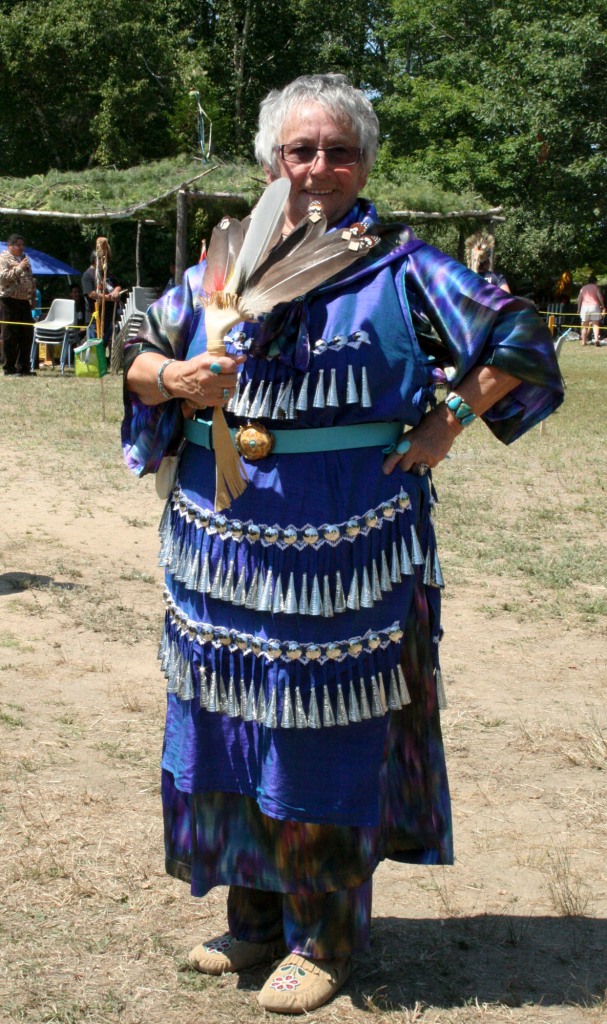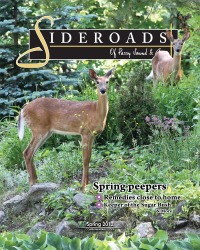
Audrey Tabobondung prepares for initiation as a jingle dress dancer at the Returning to the Circle Powwow at the Depot Harbour traditional grounds on August 31, 2011.
By Charlene Peck
When Audrey Tabobondung was initiated as a jingle dress dancer this summer, she stepped into the final stretch of a long journey of healing.
At age 73, she figures she’s probably one of the oldest women to begin this Anishnabe form of medicine dress dancing.
“It’s just one more step I wanted to take to prepare myself for the Spirit World when it’s time for me to go,” she explains.
With a backdrop of ceremonial drumming, head male dancer Waseshkung Pegahmagabow led Tabobondung and two young female dancers into the Circle on July 31, at the Wasauksing Powwow held at the Depot Harbour traditional grounds.
It was an emotional moment for Tabobondung when an outpouring of family, friends and a community of well-wishers flooded the Circle, offering support for the new jingle dress dancers.
“Well Audrey, you’ve proved it, if you can walk you can dance,” one young male dancer told her.
While she chuckles, appreciating the youthful, well-intentioned comment, Tabobondung views her role as a jingle dress dancer as a serious commitment to helping people. In choosing to wear the medicine dress, she accepts that she must always be ready for the responsibility of its spirit.
During a ceremony, when a jingle dress dancer is offered tobacco it is a solemn request for physical, mental or emotional healing.
“You can’t turn them down, you have to help them,” explains Faith Pegahmagabow, a Wasauksing First Nation women’s helper who has been guiding Tabobondung.
“When you are offered tobacco, you take that very seriously, and right away you must offer a prayer and ask for strength as a dancer to be able to do that work,” explains Deina Bomberry, a Wasauksing jingle dress dancer and dressmaker for 20 years. “You have to be able to ask the spirit to help you as you are fulfilling that responsibility.”
Tabobondung began her personal spiritual healing mission about 25 years ago. But it wasn’t until she moved to the Kenora area in 1997 and worked there as a native child welfare worker for ten years, that she realized she wanted to wear the medicine dress. Actually, the jingle dress dance is believed to have originated with the Anishnabe people of Lake of the Woods, near Kenora and part of the U.S. state of Minnesota. Tabobondung was drawn to the teaching told to her by respected elders, that a man from the Lake of the Woods area with an ill granddaughter had a vision. It’s meaning was that the jingle dress was to be given for the purpose of healing to those who believed in a traditional way of life.
“I knew in my heart I wanted to jingle dress dance a few years ago when I lived up north because of the healing the dress represented,” she says. “I knew I needed to do that, but I had to do it in my own community.”
Four years ago, she returned home and began preparing to make her jingle dress.
“It has taken me this long to take the steps in my community to get to the point of wearing this dress – where I can continue the healing journey of myself and share the healing with my community,” she explains.
“My traditional life is just beginning,” says Tabobondung, who made her first traditional drum this year. “I’ve always practiced good living, but I’ve never fully practiced a traditional life and I don’t want to pass on to the Spirit World without experiencing that.”
Although Tabobondung grew up on Parry Island, she’d always felt her own understanding of Anishnabe culture was stunted because her parents’ indoctrination into it had been repressed by their residential school experience.
“They didn’t have that because they lost it, so we were never taught it,” she says.
Making the dress has been a welcome cultural learning experience, bright with dreams about dancing. Often they’d rouse her early in the morning, calling: “Get up, get up, make yourself pretty, dress nice and be sparkly. You’ve got to sparkle and it will bring you happiness.”
Initially, she didn’t make the connection between sparkling and the shiny jingle cones on the dress. Later, the cones glistened like diamonds on water, as she laid out the blue fabric she’d chosen.
The dream and the dress were materializing and Tabobondung began discovering a deeply spiritual connection with her traditional roots.
“She’s still learning the teachings and the significance behind the dress and the responsibility of healing that it is going to bring – not only to our people but to Mother Earth, to everything in Creation and to herself as a woman – because we have to remember to heal ourselves as well,” explains Bomberry, who also teaches the girls at the Wasauksing school about the jingle dress. “So while she’s making her dress, she’s already received teaching. She might have visions or dreams about her dress that will help her. When she is rolling her cones, she is going to pray for every cone and for that understanding, and the responsibility and healing that the dress will bring.”
A jingle dancer needs to know what their role is as a healer, she explains.
“One of them is to ensure that you’re living a clean, healthy life yourself. This means that you are drug and alcohol-free. If you’re trying to heal not just people, but Creation, you need to live a clean healthy life.”
“Right now, as she’s making that dress, she’s putting her spirit into it and this will help her,” says Bomberry. “And everything she learns she will pass on to her granddaughters and nieces.”
The healing role involves gaining an understanding of the teachings of how the jingle dress came through the dream, learning the two jingle dress songs, and feasting the dress often. Jingle dress articles are smudged just before a dance and are given a cedar wash cleansing afterwards. This ensures all items are always ready when a dancer is required.
Jingle dance ceremonies are held according to need. Sometimes they’re spontaneous.
“Audrey might put her dress on and dance for someone because she knows that’s what might help,” explains Bomberry.
In the meantime, Tabobondung’s personal healing journey continues. Meaningful offerings of beads, a shell, a sweet grass turtle and more – all given with explanations of their significance in her regalia – further embellish a jingle dress she figures will never truly be complete.
“Because I’m wearing a healing dress, to me it represents part of the person who is giving it to me,” explains Tabobondung.
Today, she sparkles with the happiness prophesied in her dreams, as she offers the intrinsic healing energy of the medicine dress.
She wants to share the joy and contentment of healing that she has experienced while making her dress with the young women in her community, guiding them as they too, make jingle dresses.
At 73, she has lifetime of wisdom to impart.

